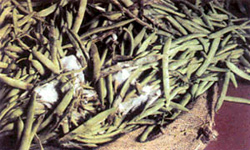Sclerotinia white rot of French bean
White rot is a destructive disease caused by a fungus (Sclerotinia sclerotiorum) that can infect all above-ground parts of french bean plants.
Host plants
This disease is polyphagus and some of the crops infected include:
- Phaseolus vulgaris (bean)
- brassica
- carrot
- coriander
- cucumber
- lettuce
- melon
- onion
- safflower
- sunflower
- tomato.
Symptoms of white rot
The following symptoms can indicate white rot:
- a watery-brown soft rot develops on stems, leaves, flowers or pods, followed by a white-cottony mould
- stem infections near soil level can lead to plant collapse (Figure 1)
- black, seed-like resting bodies called 'sclerotia' develop in the mould or in the stem pith (the tissue located in the centre of the stem).
White rot can develop on beans after harvest (Figure 2).


Preventing white rot
To prevent white rot:
- do not over irrigate, and avoid irrigation in the afternoon
- spray with a registered fungicide during flowering
- avoid planting dense crops
- plough in infected crop remains deeply
- rotate crops with at least an eight-year break between beans.
Disease development
Plants are susceptible at all ages, but most infection occurs on beans during and after flowering.
Air-borne spores (ascospores) infect old and dying flowers then the fungus grows into neighbouring tissues and organs, which are rapidly killed.
Infected flowers falling onto leaves and branches will also spread the disease within a crop. White rot may also develop on pods in transit and storage.
Spread of infection
Airborne spores are the most important means of spread and infection. Spores are ejected from the apothecia (small, orange, cup-like structures produced by the seed-like sclerotia) and are dispersed by the wind over many kilometres.
The fungus can also be transmitted through infected:
- seed
- irrigation water
- plant-to-plant contact.
Sclerotia are viable after passing through the digestive tract of animals.
Ascospores can be transmitted by bees.
Environmental conditions
The fungus likes the following conditions:
- dense plant canopies
- prolonged high humidity
- cool, wet weather.
White rot develops at temperatures ranging from 5°C to 30°C, with an optimum range of 20°C to 25°C.
Survival of resting bodies
The sclerotia can survive in the soil for anywhere from several months to over 7 years, depending on environmental conditions.
Sclerotes in the top 10 cm of soil will germinate after exposure to cool, moist conditions.
Reporting an unusual plant insect pest or disease
Report any unusual plant pest or disease immediately using our online reporting form or by calling the Exotic Plant Pest Hotline on 1800 084 881. Early reporting increases the chance of effective control and eradication.
Please take multiple good quality photos of the pests or damage to include in your report where possible, as this is essential for rapid pest and disease diagnosis and response.
Your report will be responded to by an experienced staff member, who may seek more information about the detection and explain next steps.
Report onlineReferences
Koike ST. Gladders P, Paulus AO (2007 Vegetable Diseases, A colour Handbook. Manson Publishing 448pp. ISBN 1-84076-075-3.